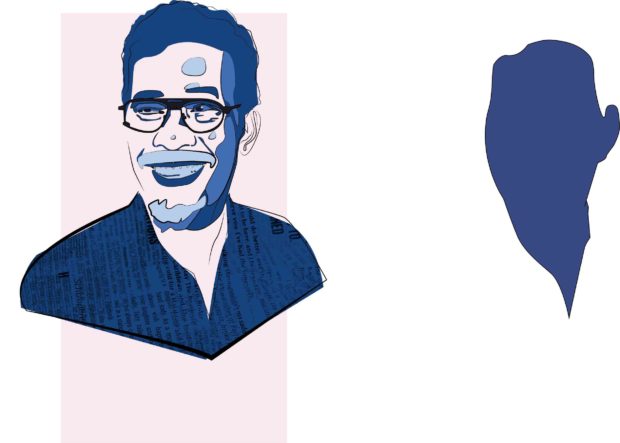Rosauro Acosta: The softie behind the booming voice

Illustration by Jake Seco
Asked what they remember most about former editor Rosauro Acosta, people who know him would most likely say: His voice.
Loud, booming and imperious, that voice dominated the different newsrooms Acosta had worked in for over 50 years. That voice also guided young journalists, including those he had mentored when he served as managing editor of the Philippine Daily Inquirer in the late 1980s and early 1990s.
But that voice could carry a tune as well, colleagues and friends at the old National Press Club bar pointed out, adding that in Acosta’s personal and professional life, music had been a constant.
One colleague still remembers his rendition of “Mam’selle,” a bittersweet song about a rendezvous in a small café. Acosta was strictly a Frank Sinatra man.
The veteran newspaperman died of a lingering illness on Aug. 4 at the Philippine Heart Center. His ashes were interred at Himlayang Pilipino four days later. He was 75.
Article continues after this advertisementAcosta’s wake at La Funeraria Paz in Quezon City was more than a gathering of friends and family; it also became an impromptu reunion of sorts among the men and women of Philippine media. Some of them described the deceased as the “last of the Mohicans,” old-school journalists who lorded over the newsrooms before, during and after the Marcos dictatorship.
Article continues after this advertisementA softie
Acosta—Roy to friends and colleagues—was a man of many contrasts. Those who knew him swear that behind that macho moustache and roaring voice was a man who cared for the industry’s “little people.”
Ester Dipasupil, who worked with him in the now defunct Times Journal in the 1980s and again in the early 2000s, described Acosta as a “softie.”
“Despite his stature in the industry, he was very approachable,” she said of the former seminarian.
Prior to his Inquirer stint, Acosta covered the Malacañang beat for the Times Journal in 1972 before becoming the paper’s assistant news editor.
“He could be intimidating to some, but people respected him because Roy knew what he was doing. [He] knew how to put a paper to bed,” said Dipasupil, who noted that above all, Acosta was a stickler for correct usage and good grammar.
As desk editor at the Inquirer in the 2000s, Dipasupil recalled how Acosta would call her up from time to time to point out grammatical lapses on that day’s paper.
Acosta joined the Inquirer as news editor in 1986 and was its managing editor until 1994. He moved on to become editor of the Business Mirror.
Radio news writer
Jovino “Bino” Bojo, who worked as a driver for the Inquirer for almost 30 years, remembered “Boss Roy” as someone who didn’t look down on others, no matter their station in life.
“[And] he was very generous—despite his being an Ilocano,” Bojo quipped.
Acosta, who studied at the University of Sto. Tomas’ Faculty of Philosophy and Letters, started his career in journalism as a radio news writer for dzHP in 1964. He worked with the likes of Joe Cantada, Jose Mari Velez, Harry Gasser, Milt Alingod, Ronnie Nathanielsz and Edward Tipton.
Shortly after, he joined the Philippines Herald in 1968 as a diplomatic reporter, and was later promoted to the Malacañang beat. He next became foreign news editor.
Taking young reporters under his wing, Acosta willingly shared with them his experiences and the knowledge he gained as a longtime journalist.
Dave Veridiano, a defense and police reporter who worked for the Inquirer for 15 years, said such mentoring helped him deliver exclusive stories from Camp Crame which shook the ground during the coup-lashed Cory Aquino administration.
Professional touch
“You’d really become a better reporter as he would guide you where to go,” Veridiano said. “I can say that he molded me to be the reporter that I am now. He was a good mentor, and I’m sure he had a great impact on many reporters.”
Another editor recalled that in the early days of the Inquirer, some editors who were closing the news pages had very little experience in putting out a newspaper. The result: cluttered and poorly designed news pages. Editors of competing papers used to rib Acosta on the Inquirer’s funny layout.
He said that Acosta helped bring “order” into the broadsheet when he started handling the news pages.
“[Roy] brought a professional touch to the unmade bed that was the Inquirer,” he said
Acosta is survived by wife Carmelita, daughter in law Mabel and granddaughters Xeres Jasmine and Xeleena Jordan.
His only child, Ceferino “Nonoy” Acosta, also a journalist, passed away in 2012.
“He had a very distinctive voice that will be missed,” Xeres said. “It was tough, but it always voiced the truth. It was always fair and had always loved Sinatra.”